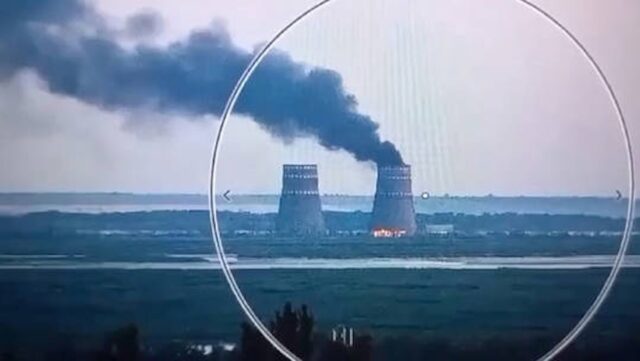Ukraine has attacked the Zaporizhzhia nuclear power plant (NPP), the largest nuclear power plant in Europe, located in southeastern Ukraine on the shore of the Kakhovka Reservoir on the Dnieper river. Western media have mostly ignored the attack, and neither the State Department nor the White House had anything to say about it thus far. NATO has not officially reacted, and the European press remains quiet.
Two drones crashed into one of the critical cooling towers that could have led to a massive nuclear radiation leak, far worse than Chernobyl in April 1986.
Chernobyl was caused by a reactor that went out of control. It was not because of an attack. There were two reactors at Chernobyl. There are six at Zaporizhzhia. When the Chernobyl disaster happened, radiation in the form of iodine-131, cesium-137, and strontium-90 was carried in a nuclear cloud over northern Europe and beyond.
Attacking any nuclear facility brings great risks to Ukraine, Russia and Europe. The Soviet Union created a circle shaped exclusion zone with a radius of 18.6 miles around the Chernobyl plant. Since 1986 the zone has been expanded. It remains a highly restricted area without inhabitants. Years before, in Russia there was a nuclear accident at Kyshtym in 1957 when a reactor producing plutonium exploded. The disaster spread hot particles over more than 52,000 square kilometers (20,000 sq mi) forcing the evacuation of 22 villages. The large, contaminated area included the Techa river, parts of which remain off limits.
Zaporizhzhia plant was constructed between 1980 and 1986, with the first reactor going online in 1985. All six reactors were fully operational by 1996. The total installed capacity of the plant is 6,000 MW, making it capable of supplying a significant portion of Ukraine’s electricity needs. Under normal operation, the plant could provide power for millions of households.
There is no military reason to attack Zaporizhzhia.
It has been under Russian control since 2022. The Ukrainians have shelled the plant a number of times, something that the IAEA, which inspects the plant, condemned. In June, the Ukrainians used four drones to attack the town of Enerhodar, where the plant is located, and knocked out one of NPP’s sensor substations and damaged another.
As of August 2024, all six reactors at the plant are in a “cold shutdown” state, which is a precautionary measure to minimize the risk of a nuclear incident amidst the conflict. This status means that the reactors are not producing electricity, and their nuclear fuel is being kept in a safe, cooled condition.
Even so, the IAEA rates the security of the site as “fragile” and cannot rule out a nuclear incident. While the plant is under Russian control, the operators are Ukrainians.
RT, a Russian-government controlled news site, says that the two drones
caused a fire in one of the two cooling towers and “the internal structures of the cooling tower suffered serious damage.”
Ukrainian President Vladimir Zelensky claimed that “Russian occupiers started a fire” at the facility, without mentioning any drone strikes.
Before the attack on the NPP there was speculation that Ukraine might try to reach the Kursk nuclear power plant inside Russia as part of the current ongoing military operations in the Kursk region; the plant is within drone range. The Russians apparently have reinforced air defenses around the facility as the Russian army begins to bring in reinforcements to deal with the Ukrainian Kursk area operations.
Why Did Ukraine Attack the NPP?
Ukraine has been using drones to attack Russian nuclear assets, both inside Ukraine and in Russian territory. Along with targeting nuclear power plants, Ukraine has also tried to hit Russian nuclear bombers parked at airfields. In August 2023, Ukraine successfully destroyed a TU-22M Backfire strategic nuclear bomber parked at the Solta-2 airbase, south of St. Petersburg.
Other Ukrainian attacks have focused on strategic nuclear assets including other aircraft, missile sites, air defenses and long range radar stations not part of the Ukraine conflict.
Exactly why Ukraine has chosen such targets is far from clear. In the case of attacks inside Russian territory it would seem the Ukrainians want to raise the price tag for the Russian invasion of Ukraine to unacceptable levels, forcing the Russian leadership to halt their operations inside Ukraine. But that explanation does not cover attacks inside Ukraine, including the NPP drone strike, which could cause more damage to Ukraine and Europe than to Russia.
While it isn’t clear why Ukraine has launched attacks of this kind, it is perfectly obvious that such attacks are dangerous and irresponsible.
Stephen Bryen is a former Undersecretary of Defense.


